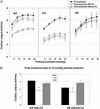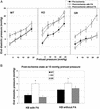Myocardial recovery from ischemia is impaired in CD36-null mice and restored by myocyte CD36 expression or medium-chain fatty acids
- PMID: 12746501
- PMCID: PMC164530
- DOI: 10.1073/pnas.1132094100
Myocardial recovery from ischemia is impaired in CD36-null mice and restored by myocyte CD36 expression or medium-chain fatty acids
Abstract
Long-chain fatty acid uptake, which provides a large part of myocardial energy, is impaired in human and murine hearts deficient in the membrane fatty acid translocase, FAT/CD36. We examined myocardial function in CD36-null mice using the working heart. Fatty acid oxidation and stores of glycogen, triglycerides, and ATP were reduced in CD36-deficient hearts and were restored to WT levels by rescue of myocyte CD36. Under normal perfusion conditions, CD36-null hearts had similar cardiac outputs and end-diastolic pressures as WT or transgenic hearts. After 6 min of ischemia, cardiac output decreased by 41% and end diastolic pressure tripled for CD36-null hearts, with no significant changes in WT or transgenic hearts. Null hearts also failed more frequently after ischemia as compared with WT or transgenics. To dissect out contribution of fatty acid uptake, a perfusate-lacking fatty acids was used. This decreased cardiac output after ischemia by 30% in WT hearts as compared with 50% for CD36-deficient hearts. End diastolic pressure, a negative index of myocardial performance, increased after ischemia in all heart types. Addition to the perfusate of a medium-chain fatty acid (caprylic acid) that does not require CD36 for uptake alleviated poor ischemic tolerance of CD36-null hearts. In summary, recovery from ischemia is compromised in CD36-deficient hearts and can be restored by CD36 rescue or by supplying medium-chain fatty acids. It would be important to determine whether the findings apply to the human situation where polymorphisms of the CD36 gene are relatively common.
Figures





References
-
- Abumrad, N., Harmon, C. & Ibrahimi, A. (1998) J. Lipid Res. 39, 2309-2318. - PubMed
-
- Abumrad, N. A., el-Maghrabi, M. R., Amri, E. Z., Lopez, E. & Grimaldi, P. A. (1993) J. Biol. Chem. 268, 17665-17668. - PubMed
-
- Tandon, N. N., Lipsky, R. H., Burgess, W. H. & Jamieson, G. A. (1989) J. Biol. Chem. 264, 7570-7575. - PubMed
-
- Oquendo, P., Hundt, E., Lawler, J. & Seed, B. (1989) Cell 58, 95-101. - PubMed
-
- Harmon, C. M. & Abumrad, N. A. (1993) J. Membr. Biol. 133, 43-49. - PubMed
Publication types
MeSH terms
Substances
Grants and funding
LinkOut - more resources
Full Text Sources
Other Literature Sources
Molecular Biology Databases

